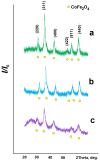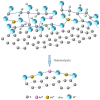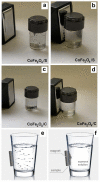Study of the Possibility of Using Sol-Gel Technology to Obtain Magnetic Nanoparticles Based on Transition Metal Ferrites
- PMID: 36975666
- PMCID: PMC10048471
- DOI: 10.3390/gels9030217
Study of the Possibility of Using Sol-Gel Technology to Obtain Magnetic Nanoparticles Based on Transition Metal Ferrites
Abstract
The article presents results for the magnetic nanoparticles sol-gel method synthesis of cobalt (II) ferrite and organic-inorganic composite materials based on it. The obtained materials were characterized using X-ray phase analysis, scanning and transmission electron microscopy, Scherrer, Brunauer-Emmett-Teller (BET) methods. A composite materials formation mechanism is proposed, which includes a gelation stage where transition element cation chelate complexes react with citric acid and subsequently decompose under heating. The fundamental possibility of obtaining an organo-inorganic composite material based on cobalt (II) ferrite and an organic carrier using the presented method has been proved. Composite materials formation is established to lead to a significant (5-9 times) increase in the sample surface area. Materials with a developed surface are formed: the surface area measured by the BET method is 83-143 m2/g. The resulting composite materials have sufficient magnetic properties to be mobile in a magnetic field. Consequently, wide possibilities for polyfunctional materials synthesis open up for various applications in medicine.
Keywords: cobalt (II) ferrite; composite materials; magnetic composites; magnetic nanoparticles; sol–gel method.
Conflict of interest statement
The authors declare no conflict of interest. The funders had no role in the design of the study; in the collection, analyses, or interpretation of data; in the writing of the manuscript; or in the decision to publish the results.
Figures







References
-
- Fan X., Liu S., Ruan K. Application of Magnetic Nanoparticles Fe3O4 in the Field of Orthopedics and Medicine; Proceedings of the 2021 2nd International Academic Conference on Energy Conservation, Environmental Protection and Energy Science, ICEPE 2021; Shanghai, China. 4–5 July 2021; - DOI
-
- Koksharov Y.A., Khomutov G.B., Taranov I.V., Gulyaev Y.V., Gubin S.P. Magnetic nanoparticles in medicine: Progress, problems, and advances. J. Commun. Technol. Electron. 2022;67:101–116. doi: 10.1134/S1064226922020073. - DOI
-
- Taheri M., Mohebat R., Moslemin M.H. Facile synthesis of ZnO-H3PW12O40@Fe3O4/EN-MIL-101(CR) as magnetic core-shell nanoparticles derived from metal-organic frameworks: Application in medicine and its catalytic activity. Mol. Cryst. Liq. Cryst. 2021;730:1954276. doi: 10.1080/15421406.2021.1954276. - DOI
Grants and funding
LinkOut - more resources
Full Text Sources

